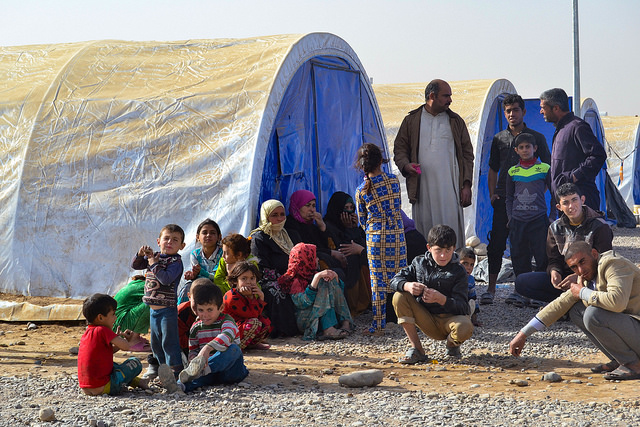In February, Iraq and its international allies, including the US, commenced a military offensive to take control from ISIS of the western part of the city of Mosul, where hundreds of thousands of people live.
The casualty tallies available from monitoring groups, as well as investigations by organisations present in the area, suggest that the use of explosive weapons in populated areas by all parties in this battle has caused considerable numbers of civilian deaths and injuries. The monitoring group Airwars, a member of INEW, has for example reported a near four-fold increase in March of reports of civilian casualties from international coalition airstrikes in Iraq and Syria, due significantly to action in Mosul.

Civilians displaced by fighting in Mosul at an IDP camp (UK DFID https://flic.kr/p/PuyAP3)
Reports from UNHCR and other agencies also suggest that continuous airstrikes, shelling, and the use of mortars in the city are tactics that have been key drivers of displacement, with families reporting these as a major reason for leaving. Though the Iraqi government has encouraged people to stay in their homes during the offensive (and ISIS has reportedly tried to stop civilians leaving), the use of explosive weapons in populated areas, along with the lack of food, water and basic services (which may in turn be related to the reverberating effects of such actions) has meant many have had to leave.
Aid agencies had prepared for the displacement of people from the city in anticipation of the humanitarian situation expected to result from the planned military action – though INEW member Oxfam noted higher numbers than expected in the first weeks of the western Mosul offensive. Others warned of potentially higher civilian casualties than in the east Mosul offensive if the same tactics were used, because of the west of the city being a more densely populated area.
However, the harm to civilians currently being seen in Mosul should not be regarded as an inevitable result of military action.Explosive weapons with wide-area effects – such as air dropped bombs with high explosive yields, multiple launch rocket systems that disperse explosives over a large area, and inaccurate or imprecise systems like mortars – pose the greatest risk to civilians when used in populated areas, even if directed against military targets. INEW has therefore called for states to stop using such weapons in populated areas, and to make a political commitment to that effect. The UN Secretary-General has made a similar call, and states have commenced a process to agree a political declaration on protecting civilians from the use of explosive weapons in populated areas.

West Mosul after days of heavy fighting (Quentin Bruno https://flic.kr/p/T5jZ9J)
In Mosul, investigations by Amnesty International and Human Rights Watch have documented the widespread use of mortars in populated areas by Iraqi forces and ISIS; the use of improvised rocket-assisted munitions by Iraqi forces that cannot be accurately directed; and international airstrikes, rocket and artillery strikes that have destroyed whole buildings or multiple buildings in a row. Using these wide area effect weapons extensively is likely to be causing particular harm to civilians. All parties to the conflict should stop employing such weapons immediately. Iraqi security forces already previously reported to INEW member the Center for Civilians in Conflict that they were instructed not to use artillery in populated areas.
In the context of this documentation of the use of explosive weapons with wide area effects, and accompanying reports of ISIS using residential buildings to treat occupants as human shields, evidence that the US military has lowered the level of authorisation needed for airstrikes that Iraqi forces have called in is particularly concerning. The area effects of certain explosive weapons are already recognised in military policy and practice as having a direct link to the risks posed to civilians – and procedures to limit such harm include raising the rank at which particular actions must be approved. If airstrikes, particularly using larger munitions, can be deployed more easily, the risks of further extensive harm to civilians in the city of Mosul is high.
All parties to the conflict must protect the civilians that remain in Mosul from the harm caused by explosive weapons, through the intense and undoubtedly challenging battle for its control.
According to data gathered by Action on Armed Violence (AOAV), 59,825 people have been reported killed or injured in Iraq from explosive weapon use between 2011 and 2016. Of these 79% (47,365) were civilians. 90% (42,417) of all civilian deaths and injuries from explosive weapons in Iraq during this period have been occurred in populated areas – and when explosive weapons have been used in populated areas in Iraq, 93% of those killed or injured were civilians.
Read more
Center for Civilians in Conflict: Policy Brief on Civilian Protection in the Current Mosul Campaign
Human Rights Watch: Airstrike Vetting Changes Raise Concerns
PAX: Syria & Iraq Alert III: protect civilians in Mosul and Raqqa
